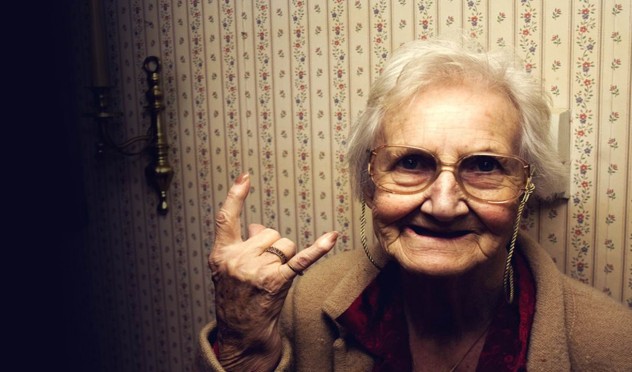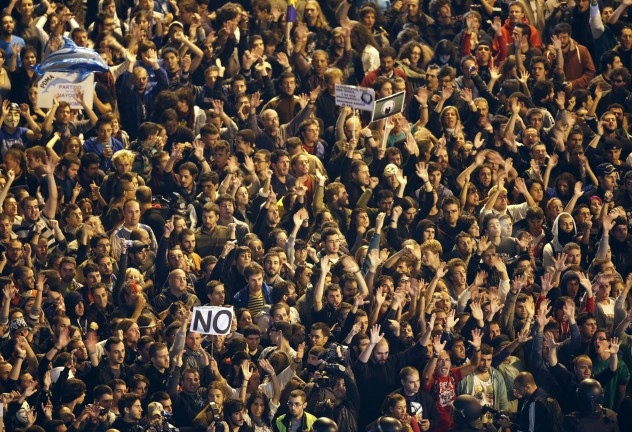 Weird Stuff
Weird Stuff  Weird Stuff
Weird Stuff  Mysteries
Mysteries 10 Tragic Disappearances and Deaths in Joshua Tree National Park
 History
History 10 Ways Childhood Really Sucked in the Old West
 Music
Music 10 Name Origins of Famous Bands from the 1990s
 Religion
Religion 10 Biggest Turnarounds by the Catholic Church
 Weird Stuff
Weird Stuff 10 Unbelievable Times Laws Had Unintended Consequences
 Humans
Humans Ten Historic Women Who Deserve Way More Credit Than They Got
 Movies and TV
Movies and TV 10 Films That Spawned Major Lawsuits
 History
History Ten Times Towns Were Wiped Off the Face of the Earth
 Creepy
Creepy 10 of the Most Disturbingly Haunted Public Houses in the UK
 Weird Stuff
Weird Stuff 10 Niche Subcultures That Are More Popular Than You Might Think
 Mysteries
Mysteries 10 Tragic Disappearances and Deaths in Joshua Tree National Park
 History
History 10 Ways Childhood Really Sucked in the Old West
Who's Behind Listverse?

Jamie Frater
Head Editor
Jamie founded Listverse due to an insatiable desire to share fascinating, obscure, and bizarre facts. He has been a guest speaker on numerous national radio and television stations and is a five time published author.
More About Us Music
Music 10 Name Origins of Famous Bands from the 1990s
 Religion
Religion 10 Biggest Turnarounds by the Catholic Church
 Weird Stuff
Weird Stuff 10 Unbelievable Times Laws Had Unintended Consequences
 Humans
Humans Ten Historic Women Who Deserve Way More Credit Than They Got
 Movies and TV
Movies and TV 10 Films That Spawned Major Lawsuits
 History
History Ten Times Towns Were Wiped Off the Face of the Earth
 Creepy
Creepy 10 of the Most Disturbingly Haunted Public Houses in the UK
10 Arguments for Legalizing Euthanasia
Euthanasia is an issue most politicians wouldn’t touch with a long pole. And with good reason: Any argument on the subject usually devolves into a series of complex, abstract questions about morality, freedom of choice, and so on. But while these ideas do have their place in the debate, they usually serve only to eclipse the other, better reasons we have for considering legalization—reasons that involve evidence, lived experience, and hard statistics.
10It Doesn’t Shorten Life

One of the big arguments against euthanasia is that it’s irreversible: Once the patient is gone, we’ll never know if their unexpected recovery was just around the corner or if they might have gone on to lead full and happy lives despite their illness. However, this argument ignores the data so hard it basically punches reason in the face. The fact is, in all nations where euthanasia is legal, it’s the near-exclusive preserve of the terminally ill. And, despite what hopeful evangelicals and daytime dramas would have us believe, terminal illness is usually exactly that: the final stop before death. In 1991, a Dutch report into euthanasia found that in 86 percent of cases, euthanasia shortened life by a maximum of a week and usually only a few hours. In other words, it was a last resort—an escape hatch used by patients in unbearable agony who would rather that agony ended now than in two days.[1]
Now, this isn’t to say that miracle recoveries never happen: They occasionally do. But the reason you hear about them is that they’re so statistically improbable. For most patients, such a recovery is less likely than winning the lottery and getting struck by lightning in the same afternoon.
9It Saves Lives

Not only does legalizing euthanasia not significantly shorten life, but it’s also been proven actually to save lives. Don’t believe me? Well, you’ve only got to look to the Netherlands, where they’ve had progressive laws on assisted dying for over a decade now. In 2005, a study by the New England Journal of Medicine found that only 0.4 percent of all euthanasia procedures were carried out without the patient’s explicit permission. You might argue that that’s 0.4 percent too many, but get this: A 1991 report—written a decade before euthanasia was legalized—put the number at 0.8 percent. In other words, giving a nationwide go-ahead for doctors to legally end their patient’s lives actually halved the number of unwanted deaths.[2]
But hey, that’s just Holland, right? They do things differently there. Doctors in a less-hippie-liberal culture would never kill off patients without their consent, right? Well, think again. In Britain, a 2012 study discovered that as many as 57,000 patients each year die without being told that efforts to keep them alive have been stopped. Instead, they’re just shoved onto a “death pathway” designed to alleviate suffering without ever being told. So basically, doctors in the UK are already practicing euthanasia—only without any legal framework to check abuses that would come from legalizing it.
8 The Public Supports It

Way back in 1947, Gallup started asking the general public if they supported doctors being allowed to end a patient’s life “by some painless means if the patient and his or her family request it.” Since 1964, the public has overwhelmingly returned a “yes” vote—with current support standing at 70 percent. That 70 percent, by the way, includes two-thirds of all Republican voters and nearly as many Dems, suggesting strong cross-party support. But here’s the kicker: Even when Gallup changed the wording of their question to remove all references to “painless means” and family consent—and deliberately stuck in the divisive word “suicide”—over half of the electorate still supported allowing patients the right to die. In other words, the public overwhelmingly supports the concept, even when it’s made to sound as unattractive as possible.[3]
7It Makes Economic Sense

Most people would be shocked to think economics factored into their life-or-death decisions, and rightly so. However, there’s no getting around how absurdly expensive end-of-life care is in America. According to NPR News, about 10 percent of all healthcare dollars spent goes toward end-of-life-care.[4] The upshot of this is often crippling debt for the families of terminally ill patients, with the care of a single individual at the end of their life costing an estimated $39,000. For 40 percent of households, the bill exceeds their financial assets.
This might be acceptable if end-of-life care was worth the money, but it’s objectively not. Doctors will readily attest to the ability of modern medicine to slightly prolong life—at the cost of destroying its quality. If you can’t be bothered to read that last link, I’ll sum it up here: End-of-life care is often brutal, nasty, traumatic, and very expensive, putting patients through long stretches of unnecessary suffering just to give them an extra month or two. And when the terminally ill patient undergoing these nasty, expensive treatments has repeatedly insisted that they’d rather be dead, you have to start wondering who all this expenditure is really benefiting.
6It Improves Quality Of Life

Most of us fear death, but a large part of that fear comes from uncertainty and the worry that it might be preceded by agonizing pain (like a car wreck, say). If we knew exactly when we were going to die—and knew for a fact it would be painless—it’s a fair bet that fear would simply melt away. By allowing people to choose the how and when of their death, we’re guaranteeing they’ll live what remaining life they have to the fullest, free from the pain of anxiety. Don’t believe me? Well, here’s author Terry Pratchett saying pretty much the exact same thing. After being diagnosed with a rare form of Alzheimer’s, the Discworld writer became a campaigner for assisted dying. In his own words:
“As I have said, I would like to die peacefully with Thomas Tallis on my iPod before the disease takes me over, and I hope that will not be for quite some time to come, because if I knew that I could die at any time I wanted, then suddenly every day would be as precious as a million pounds. If I knew that I could die, I would live. My life, my death, my choice.”[5]
5 It Won’t Target The Vulnerable

One of the big myths about legalizing assisted dying is that it will pressure the old, disabled, and infirm to end their lives. It’s an understandable fear and one we shouldn’t take lightly: However, it also has absolutely no basis in fact.
Take Oregon. In 1994, it became the first state in America to legalize assisted dying, with the law going into effect in 1998. Ten years later, the number of doctor-assisted suicides stood at 341—not 341 per year, but 341 per decade.[6] That works out to about 0.2 percent of all patient deaths—a number so tiny it hardly seems worth mentioning. In 2007, the Journal of Medical Ethics analyzed the cases of every single patient who’d opted for the service and found poor, elderly, minority, or otherwise “vulnerable” groups were represented as infrequently as everyone else. In other words, the vulnerable were no more likely to receive assisted death than anyone else, with the sole exception of young white men—who were the primary users of the service. And if there’s one group that doesn’t need classifying as “vulnerable,” it’s young white men.
4Current Laws Target the Innocent

In 2013, a court in Ireland rejected ex-lecturer Marie Fleming’s bid to commit suicide, despite multiple sclerosis reducing her life to “irreversible agony.” At the center of this dispute was her partner Tom, who was told he could face up to 14 years in prison if he helped her die. In other words, with a stroke of their pen, Ireland’s top court condemned a woman to live in unimaginable physical agony while also saddling her partner with an impossible choice: to watch the person he loves suffer daily or help relieve her pain and go to prison. This should count as institutional cruelty by any sane reckoning, yet rulings like this happen all the time.
Take the case of paralyzed UK resident Paul Lamb. Also in 2013, a judge ruled that any nurse or doctor who helped him take his own life would be prosecuted, despite Lamb describing his life as a “living hell.”[7] Or the case of Diane Pretty who in 2002 was told her husband would be prosecuted if he tried to help her avoid the horrible death she eventually had. Simply put, laws against assisted death cause suffering on an unprecedented scale, not just for the terminally ill but their families as well.
3Psychological Acceptance of Dying

When we think about death, most of us imagine passing serenely away surrounded by our loved ones—maybe after having a slap-up meal and the best sex of our lives. But death isn’t like that. Death is usually slow, painful, and undignified. And by refusing people the “right” to end their own lives, we’re increasing that pain and indignity to a horrifying extent. But it isn’t just physical, and there’s historical precedence for the practice.
The notion of euthanasia is not new; it dates back more than 2,000 years. Contrary to current understanding, euthanasia had an entirely different meaning during the pre-Socratic era.1 The concept of euthanasia evolved before the discovery of lethal chemicals to assist the dying patient. The original notion of euthanasia was that of the physician preparing the patient for a peaceful death by attempting to relieve the psychological distress accompanying the dying process. More than two millennia later, we can confirm that the psychological element of suffering, the ancient physician’s primary concern, is the most common reason for today’s requests for euthanasia. The Remmelink report from the Netherlands in 1991 clearly shows that patients who request euthanasia are more concerned with psychological distress than physical suffering.[8]
Those with terminal and debilitating diseases often cannot physically move or function, yet their minds remain clear, providing the means to dwell on their condition as they wait for natural death to occur. The fear of dying and the waiting for it to happen may be even more difficult to handle than the physical pain of a dying person’s condition.
2It Won’t Open the Floodgates

A final myth is that legalizing assisted dying will open the floodgates, leading to a murder-happy world where life is cheap, and death is easy. But analysis of the data shows that this isn’t the case. Let’s bounce back to the Netherlands for a moment: Every year, roughly 3,000 Dutch people seek to be euthanized. That sounds like a lot until you realize it accounts for only 1.7 percent of all deaths. And the application is no guarantee of acceptance, either. Far from making death cheap, the Netherlands’s system of assisted dying has made it complex, bureaucratic, and very difficult to achieve. Around two-thirds of patients who apply to be euthanized are refused, while euthanasia itself remains a criminal act unless carried out by a qualified doctor with the consent of a legal and an ethics expert. In short, getting your doctor to relieve your suffering even in the liberal Netherlands is nigh-on impossible—hardly the sort of trigger-happy climate pundits would have you believe it was.[9]
1 The Hippocratic Oath

The famous maxim “do no harm” is a summation of the Hippocratic Oath—an ancient code designed to guide doctors in their actions. Many people interpret this to mean “do nothing to harm the patient’s chances of survival.” But, taken literally, it could just as easily mean “don’t artificially keep someone alive when death is preferable.”
It all comes down to what we believe constitutes “harm.” When a patient is in intense pain or suffering severe mental anguish, our society could be doing more harm by keeping them alive than allowing them to die. In extreme cases, such as those of Tony Nicklinson[10] and Paul Lamb above, it could be argued that any physician who didn’t alleviate their suffering when asked was violating the principles of their oath—and allowing both great harm and a great injustice to occur on their watch. At the end of the day, it’s up for us to decide whether we can sit back and watch people suffer or choose to do something about it. Until we make up our minds, that suffering will continue.

